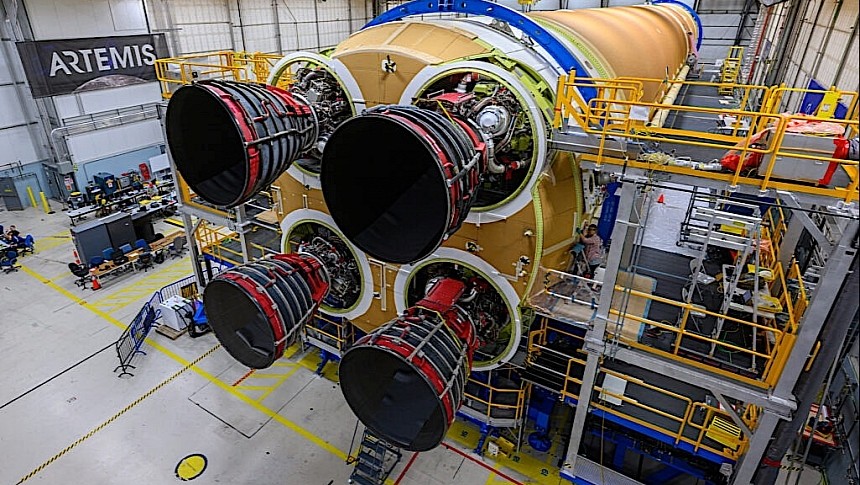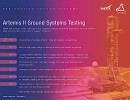There is a little over a year left until the Artemis program sends its first crew on a trip to Moon. For most of us, a year is a very long time, but that's probably not how it feels for the people working on the mission's rocket and spaceship.
Hard at work in several of NASA's facilities, literal rocket scientists are quickly advancing with the integration of all the required systems, but even so they'll probably just be done by the time Artemis II lifts off in November 2024.
Earlier in September, for instance, we learned of the Space Launch System (SLS) rocket's core stage having been fitted with the first of four RS-25 engines that'll help it take off from the launch pad. Just a couple of weeks later NASA says all four engines are now in place.
The RS-25 is a kind of engine that was initially developed for the Space Shuttle. In fact, some of the engines that actually flew Shuttle missions have made their way on the SLS: two of the four are repurposed and reused (with the veteran among them having been already fired on 15 missions), while the other two are brand new, but using the same design.
The combined power of the four RS-25 rocket engines should be enough to generate a massive two million pounds of thrust for the first eight minutes of flight, greatly contributing to the rocket's lifting power.
But the units are not alone in their task, as two boosters will also be on deck to help, shooting the rocket's total output to a staggering 8.8 million pounds of thrust at take-off. And these pieces of hardware were just delivered to the Kennedy Space Center in Florida from the Northrop Grumman facility in Utah, where they were made.
The boosters, separated into ten segments, traveled by train across eight states, carefully looked after by specialized crews. They reached Kennedy on September 25, and they're currently being inspected for potential issues.
If the all-clear is given, the segments will be rotated upright and prepared for stacking with the core stage of the SLS.
Artemis II is humanity's first crewed mission to the Moon in decades. It's not a trip that will actually see humans touch down up there, but it will set the record for the farthest distance ever traveled by a member of our species: 230,000 miles (370,000 km) from Earth, and 6,400 miles (10,300 km) beyond the Moon.
The crew is four people strong, and includes, for the first time on a NASA Moon mission, a person of color and a woman. The four brave souls leaving for the Moon next year are mission commander Reid Wiseman, pilot Victor Glover, mission specialist Christina Hammock Koch, and mission specialist Jeremy Hansen.
Earlier in September, for instance, we learned of the Space Launch System (SLS) rocket's core stage having been fitted with the first of four RS-25 engines that'll help it take off from the launch pad. Just a couple of weeks later NASA says all four engines are now in place.
The RS-25 is a kind of engine that was initially developed for the Space Shuttle. In fact, some of the engines that actually flew Shuttle missions have made their way on the SLS: two of the four are repurposed and reused (with the veteran among them having been already fired on 15 missions), while the other two are brand new, but using the same design.
The combined power of the four RS-25 rocket engines should be enough to generate a massive two million pounds of thrust for the first eight minutes of flight, greatly contributing to the rocket's lifting power.
But the units are not alone in their task, as two boosters will also be on deck to help, shooting the rocket's total output to a staggering 8.8 million pounds of thrust at take-off. And these pieces of hardware were just delivered to the Kennedy Space Center in Florida from the Northrop Grumman facility in Utah, where they were made.
The boosters, separated into ten segments, traveled by train across eight states, carefully looked after by specialized crews. They reached Kennedy on September 25, and they're currently being inspected for potential issues.
If the all-clear is given, the segments will be rotated upright and prepared for stacking with the core stage of the SLS.
Artemis II is humanity's first crewed mission to the Moon in decades. It's not a trip that will actually see humans touch down up there, but it will set the record for the farthest distance ever traveled by a member of our species: 230,000 miles (370,000 km) from Earth, and 6,400 miles (10,300 km) beyond the Moon.
The crew is four people strong, and includes, for the first time on a NASA Moon mission, a person of color and a woman. The four brave souls leaving for the Moon next year are mission commander Reid Wiseman, pilot Victor Glover, mission specialist Christina Hammock Koch, and mission specialist Jeremy Hansen.












